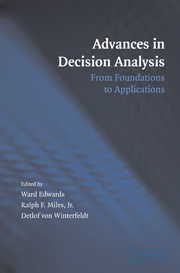Book contents
- Frontmatter
- Contents
- List of Contributors
- Preface
- 1 Introduction
- PART I HISTORY AND FOUNDATIONS OF DECISION ANALYSIS
- PART II STRUCTURING DECISION PROBLEMS
- PART III PROBABILITIES AND BAYES NETS
- 8 Eliciting Probabilities from Experts
- 9 Aggregating Probability Distributions
- 10 Model Building with Belief Networks and Influence Diagrams
- 11 A Bayesian Approach to Learning Causal Networks
- PART IV UTILITIES
- PART V RISK ANALYSIS
- PART VI DECISION ANALYSIS IN A BEHAVIORAL AND ORGANIZATIONAL CONTEXT
- PART VII APPLICATIONS OF DECISION ANALYSIS
- Index
- References
8 - Eliciting Probabilities from Experts
Published online by Cambridge University Press: 05 June 2012
- Frontmatter
- Contents
- List of Contributors
- Preface
- 1 Introduction
- PART I HISTORY AND FOUNDATIONS OF DECISION ANALYSIS
- PART II STRUCTURING DECISION PROBLEMS
- PART III PROBABILITIES AND BAYES NETS
- 8 Eliciting Probabilities from Experts
- 9 Aggregating Probability Distributions
- 10 Model Building with Belief Networks and Influence Diagrams
- 11 A Bayesian Approach to Learning Causal Networks
- PART IV UTILITIES
- PART V RISK ANALYSIS
- PART VI DECISION ANALYSIS IN A BEHAVIORAL AND ORGANIZATIONAL CONTEXT
- PART VII APPLICATIONS OF DECISION ANALYSIS
- Index
- References
Summary
ABSTRACT. Decision models sometimes require the use of expert judgments to quantify uncertainties. Modes and methods for eliciting probabilities are presented in this chapter. Criteria for selecting issues and experts are discussed and protocols for acquiring these judgments derived from research and practice are described. These protocols are designed to eliminate problems that sometimes arise when using experts for uncertainty quantification. A range of considerations for organizing a probability elicitation is presented as a guide for developing a protocol for a given situation. The identification and avoidance of psychological biases arising from the application of heuristics is discussed as important background for probability elicitation. Probability training is presented as one method for reducing these biases. Measures of the goodness of assessed probabilities and probability distributions such as calibration measures and proper scores are given. Methods for completing a distribution from assessment fractiles are shown.
The ability of decision analysis to deal with significant uncertainties is one of its most attractive features. Probabilities or probability distributions provide the primary means for integrating uncertainties into a decision model. Often times, however, the acquisition of probabilistic information is, itself, a challenge. One method of developing probabilistic input for a decision model is to engage experts who have special knowledge about the likelihood of values or events in question. In order that the judgments of these experts be integrated with other types of information in the decision analysis, they should be codified as probabilities.
- Type
- Chapter
- Information
- Advances in Decision AnalysisFrom Foundations to Applications, pp. 129 - 153Publisher: Cambridge University PressPrint publication year: 2007
References
- 45
- Cited by

